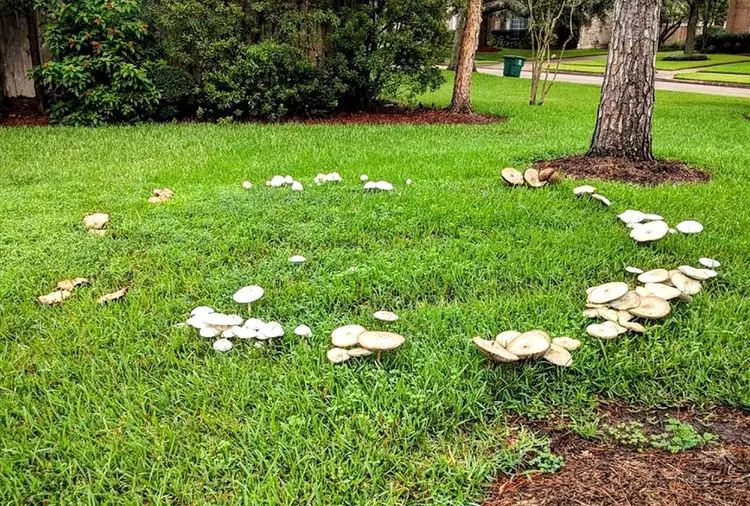Fairy rings are steeped in folklore. It’s easy to see how they acquired a mystical reputation. In many cases, the nearly perfect circles of lush green grass or mushrooms pop up overnight. Like magic, a patch of mundane lawn suddenly sports a 3- to 15-foot diameter circle or partial circle. What gives? And are these fairy rings in lawn harmful to your grass? Find out these answers, and get tips for preventing fairy rings in your lawn.
What Causes Fairy Rings?
Legend has it that a band of merry fairies dancing in a circle on the lawn at night causes a fairy ring. By morning, all that remains of the moonlit party is a circle of extra green grass or toadstools. Looking into the true origin of fairy rings reveals that they result from a certain set of soil properties.
Healthy soil is alive with all kinds of organisms, such as worms, bacteria, and fungi. Fairy rings form when a particular fungus is exceptionally active in the soil. Fairy ring fungi feed on decaying organic matter from tree stumps, roots, and twigs buried in the soil. As fungi feed, they release nitrogen in a relatively circular pattern. Nitrogen promotes lush green growth in the grass, creating the green circle of turf associated with a fairy ring. Some fairy ring fungi produce mushrooms in a similar circular fashion.
Types of Fairy Rings
There are three types of fairy rings. They differ based on the soil characteristics, the fungus involved, and the environmental conditions.
Type 1 fairy rings are the most destructive. The fungi that create Type 1 rings produce compounds that limit the soil’s ability to absorb water. Without the ability to absorb water, drought conditions quickly develop, and the grass in the affected ring turns brown and dies. Type 1 fairy rings are most common on highly manicured golf course putting greens; they rarely develop on home lawns.
Type 2 fairy rings are known for their bright green circles or partial circles of turf. These fairy rings are fueled by fungi that rapidly release nitrogen as they decay organic matter. Most common near buried tree stumps, logs, leaves, and woody masses of roots, Type 2 fairy rings are most evident in lawn grass that is deficient in nutrients. Fertilize the surrounding lawn with a nitrogen fertilizer to promote strong growth throughout the turf and minimize the appearance of the nitrogen-fueled ring. Hot, dry weather bolsters the work of fungi that cause Type 2 fairy rings. When the weather pattern changes, the fairy ring will likely fade.
Finally, Type 3 fairy rings are characterized by a ring or partial ring of mushrooms that pop up in the turf. Most prevalent during extended periods of wet weather, Type 3 fairy rings occur most frequently in poorly drained soil and over-irrigated turf grass. When dry conditions prevail, Type 3 fairy rings are rare.
How to Prevent Fairy Rings
A healthy stand of turf grass fends off over-exuberant soil fungi that cause fairy rings. Proper mowing height, irrigation, and fertilization combine to pave the way for a thriving, fairy-ring-free lawn.
Mow properly.
Keep traditional lawn grass, such as Kentucky bluegrass, mowed no shorter than 3 inches tall. Cutting the grass too short causes stress that makes the turf susceptible to pests and disease. High or irregular mowing leads to a buildup of clippings, or thatch, on the soil surface, interfering with water and oxygen penetration. Mow as often as needed, depending on growing conditions, to maintain your grass between 3 and 4 inches tall.
Water smart.
Overwatering your lawn is more troublesome than not watering enough. Turf grass naturally goes dormant during prolonged dry periods. While the appearance of a dormant lawn is not as appealing as actively growing green grass, it's often far healthier than over-irrigated grass. The environmental benefits of no or limited irrigation are notable. If you must irrigate, manually set your irrigation system based on the weather conditions in your area rather than relying on a schedule that doesn’t account for natural rainfall.
Fertilize as needed.
Grass fertilizer needs are based on the nutrient makeup of the soil. Lawns growing in rich loam need far fewer fertilizer applications than those growing in fast-draining sandy soil. Get to know your soil and set a fertilizer plan based on the characteristics of the yard. A soil test is an easy way to learn more about your soil.




















